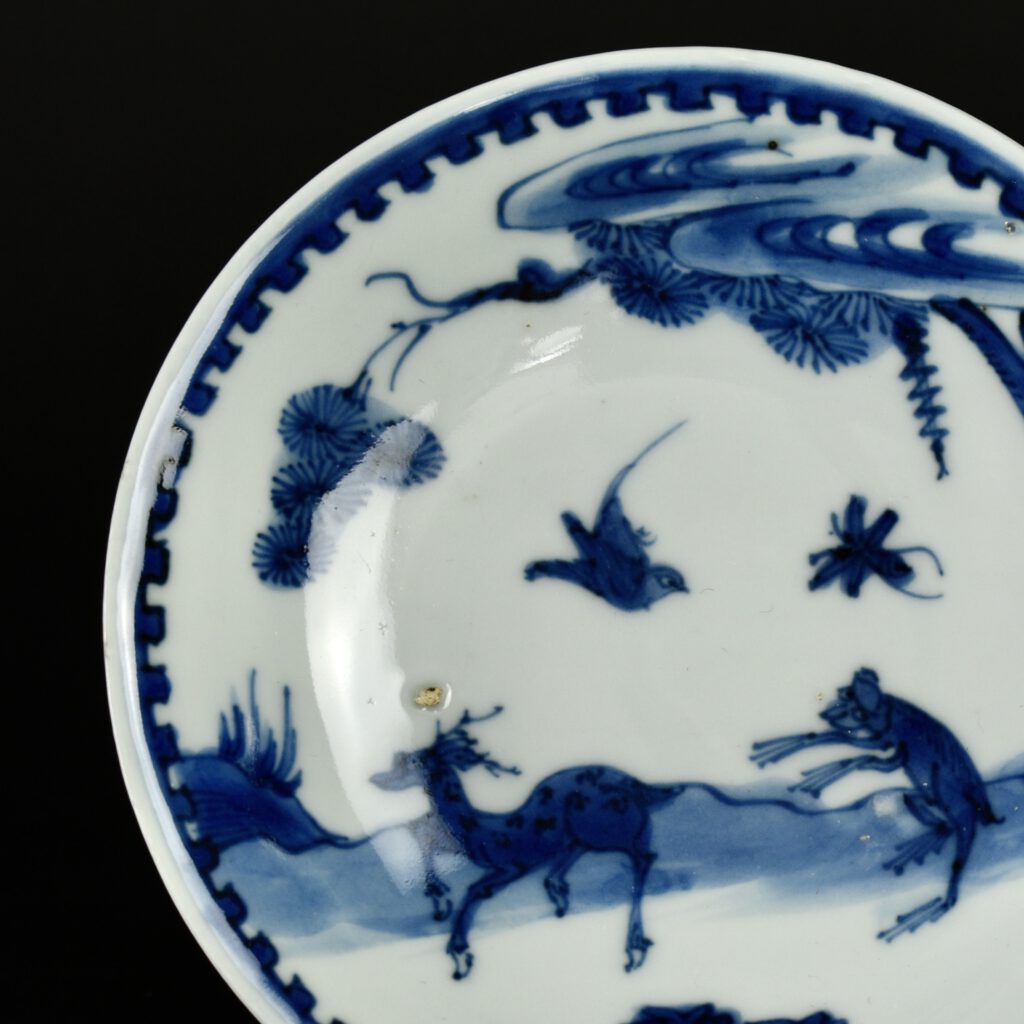
A Ming Porcelain Dish From The Peony Pavilion Collection
A Late Ming Blue and White Porcelain Dish for the Japanese Market, Tianqi Period 1620 – 1627. This late Ming porcelain dish would have been a Kaiseki, a serving for the Japanese Tea Ceremony meal. The design is of a monkey walking towards a deer, a wasp above with a bird in flight and a pine tree to the right. Parts of this design forms the rebus, juelu fenghou, meaning ‘may you receive high rank and emolument’. The elements taken from the design to create the rebus are ; monkey is hou with a deer lu and wasps feng. The entry for these five Ming dishes in the Peony Pavilion Catalogue has a footnote “A related polychrome example is illustrated in Transitional Wares and Their Forerunners, op. cit., p139″. We sold that dish earlier in the year (2020). See the photograph and reference below the ‘photograph gallery’. The polychrome dish was published and exhibited by the Oriental Ceramics Society of Hong Kong at the Hong Kong Museum of Art in 1981 (see References). There were five of these Ming blue and white Kaiseki dishes sold as lot 294 in the Peony Pavilion Sale in 1989, they came with a box for ten dishes. The other five from the set were sold by Christie’s as lot 295. Box Not Included.
SOLD
- Condition
- In good condition, minor mushikui frits. Some kiln grit to the front.
- Size
- Diameter 14.8 cm (5 3/4 inches)
- Provenance
- Published : The Peony Pavilion Collection ; Chinese Tea Ceramics for Japan (c.1580-1650). Christie`s London 12th June 1989, lot 294. Sold £1,650 (set of 5). From a Private Collection, they purchased this piece as well as many others from the Christie's sale of 1989. I was able to buy the complete group from this private collection.
- Stock number
- 25940
- References
- A related polychrome example sold by Robert McPherson Antiques was exhibited in Hong Kong in 1981 see : Transitional Wares and Their Forerunners' (An exhibition presented by the Oriental Ceramics Society of Hong Kong at the Hong Kong Museum of Art in 1981) page 139, colour plate 162.
Information
A Related Ming Porcelain Dish Sold by Robert McPherson Antiques
See 'Sold Archive' stock number 26044.
A Ming Wucai Porcelain Kaiseki Serving Dish, Early Chongzhen Period c.1635. This Transitional Porcelain dish was made for the Japanese market for use in the Tea Ceremony. This sturdy dish is painted in under-glaze cobalt blue with the addition of overglazed red, yellow and green. The design if of a monkey seated on a rocky outcrop below a fruiting peach tree with a deer in front of him and two wasps below a bird in flight. Parts of this design forms the rebus, juelu fenghou, meaning ‘may you receive high rank and emolument’. The elements taken from the design to create the rebus are ; monkey is hou with a deer lu and wasps feng. The peach reprents the wish for long life. This dish is published in ‘Transitional Wares and Their Forerunners’ An exhibition presented by the Oriental Ceramics Society of Hong Kong at the Hong Kong Museum of Art in 1981 (see References).


Wabi - Sabi
A literal translation doesn't work well for the Japanese concept known of Wabi-Sabi. We have imprinted in us a sense of permanence connected with the Classical order, symmetry, things being right, perfect, pristine even. We know an Imperial Qing or Sèvres vase is good quality because it tells us so. The material, fine translucent porcelain, is decorated in rich colours, even gold, the surface filled with decoration that wears its wealth in clear public view. It is perfect and perhaps if we own it will get somewhere nearer perfection ourselves. The Japanese aesthetic of Wabi-Sabi shows us something quite different. Life is imperfect, we are imperfect, the art of life is to live with it. Perhaps, the nearest we get to permanence is the inevitable realisation that transience is part of the ebb and flow of how things are. Nothing is perfect, Wabi-Sabi allows us to see the beauty inherent in imperfection, the rustic and the melancholy. A potter's finger marks on the surface of a pottery bowl, the roughness of a pottery. A ceramic surface can become a landscape in which the eye walks over humble cracks, uneven, faulty, the mind in austere contemplation. Wabi-Sabi can be condensed to 'wisdom in natural simplicity'.
Wabi-Sabi stems from from Zen Buddhist thought, 'The Three Marks of Existence' ; impermanence, suffering and the emptiness or absence of self-nature. These ideas came to Japan from China in the Medieval Period, they have developed over the centuries and have greatly affected Japanese culture. For example the Japanese tea ceremony, which is the embodiment of perfection, uses ceramics which are imperfect. It was not just the pottery made in Japan that needed to have a Wabi-Sabi nature but also the Chinese porcelain made for the Japanese tea ceremony. During the late Ming dynasty the Chinese supplied Japan with porcelain for the tea ceremony, not just for the ceremony itself but for the meal that was taken with it, the Chinese even supplied charcoal burners for them to light their pipes. This Chinese porcelain was made at Jingdezhen to Japanese designs, sent from Japan. The Japanese wanted the Chinese to work against their normal way, they requested firing faults, imperfections and unevenness. The Chinese were sometimes rather too precise in their making of these imperfections, often adding faults carefully and even symmetrically. I imagined they could have thought, 'why do our customers want us to make these things so badly'. Clearly Wabi-Sabi was lost on them.












